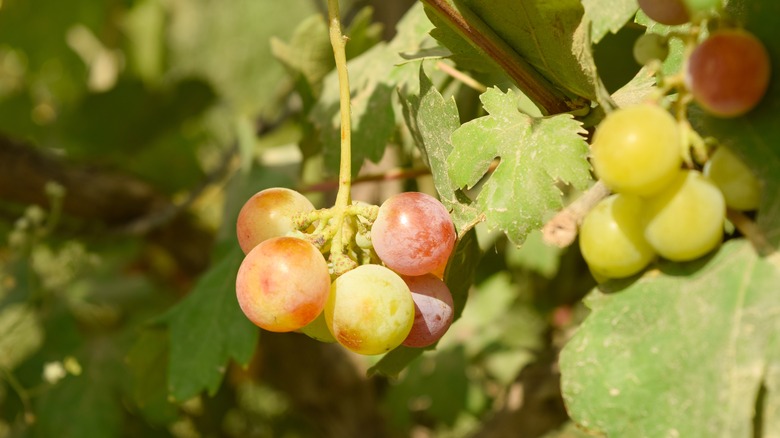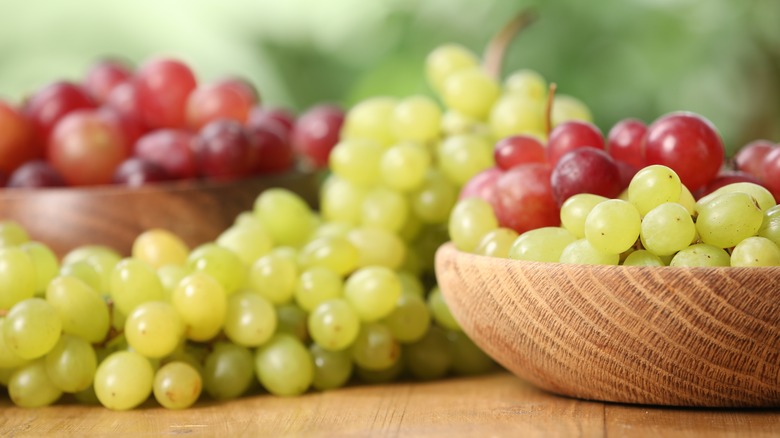Why You Don't Have To Worry About The White Stuff On Grapes
The humble grape has afforded us a great many treats over the years. From its most obvious (and arguably, most popular) use as a base for wine, to a snack (almost) straight off the vine — there's much to love about this bite-sized fruit, which is sometimes even referred to as "nature's candy." In fact, according to the International Fresh Produce Association, grapes were the fourth most purchased fruit in the U.S. in 2023, while data gathered from the USDA's National Agricultural Statistics Service found that the value of the U.S. grape industry was upwards of $5.53 million in 2021. These figures show that grapes are very clearly a part of our DNA.
And while our love for this fruit is as solid as the seed you hope not to find at its center, we do have one small issue we'd like to address — that funny white stuff on the skin. You know, the stuff that looks a lot like dirt, dust, or worse, mold. It turns out it's actually called bloom — and it's perfectly natural.
What is bloom?
"Bloom" may sound a lot like something you'd equate with mold, but it's not. It also has nothing to do with flowers. It's actually a substance produced by the grape itself, as a form of protection. Think of this waxy, whitish residue as a sort of fruity suit of armor — a barrier on the outer layer (or cuticle) of the grape that shields it from moisture loss, pests, and other hazards. Bloom can contain the wild airborne yeast Saccharomyces cerevisiae, which attaches itself to the skin of the grape and is particularly useful for the fermentation of wine. The main component of bloom, however, is oleanolic acid, which is known to possess antibiotic, antiviral, and anti-inflammatory properties and is even used in some skincare products (in other words, it's pretty powerful stuff).
Bloom occurs on all types of grapes, but it may seem moreprevalent on the darker varieties. However, this is simply a case of the colors contrasting more. You may also recall seeing it on other fruits, such as fresh blueberries and plums, where it is sometimes also referred to by the term "blush." All of this to say, the juicy grapes you enjoy eating would probably never make it to your mouth without it.
Is bloom safe to eat?
You probably know the saying that "looks can be deceiving." Never was there a case more true than that of bloom-covered grapes, which are perfectly safe to eat, despite their imperfect appearance. That said, it's a good idea to give them a quick rinse under cold water before popping in your mouth — just as you would any other fresh fruit or vegetable — to remove any traces of pesticides.
Washing off the bloom may also improve the grapes' flavor, since some people find that the bloom tastes bitter or chalky. Rest assured, that's where the issues with bloom end. "Bloom is completely safe, and usually washes away when rinsed," says Ross Jones of the California Table Grape Commission, in a video for Grapes from California. "If some bloom remains after rinsing your grapes, don't worry — there's no harm in consuming it."
On that note, be sure to only rinse grapes when it comes time to actually eat them. As just as bloom helps to preserve grapes on the vine, it also helps to keep them fresh once picked. Resist the urge to wash off this white film before popping them in the refrigerator, and they should stay in good condition for up to two weeks. As a nation positively obsessed with this bite-sized fruit, we think that's some pretty grape news.


